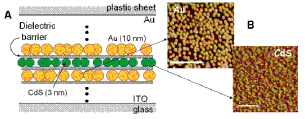Chemical and Biomolecular Research Papers -- Faculty Authors Series

Ravi Saraf Publications
Document Type
Article
Date of this Version
6-9-2006
Abstract
Touch (or tactile) sensors are gaining renewed interest as the level of sophistication in the application of minimum invasive surgery and humanoid robots increases. The spatial resolution of current large-area (greater than 1 cm2) tactile sensor lags by more than an order of magnitude compared with the human finger. By using metal and semiconducting nanoparticles, a ~100-nm-thick, large-area thin-film device is self-assembled such that the change in current density through the film and the electroluminescent light intensity are linearly proportional to the local stress. A stress image is obtained by pressing a copper grid and a United States 1-cent coin on the device and focusing the resulting electroluminescent light directly on the charge-coupled device. Both the lateral and height resolution of texture are comparable to the human finger at similar stress levels of ~10 kilopascals.


Comments
Published in SCIENCE VOL 312, 9 JUNE 2006. Copyright 2006. Used by permission. www.sciencemag.org